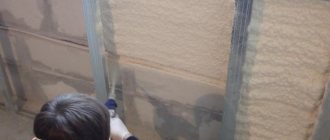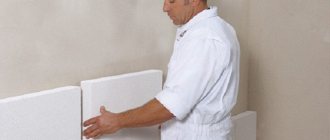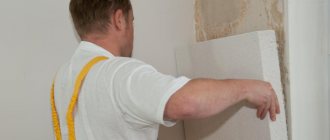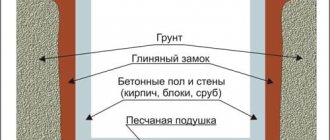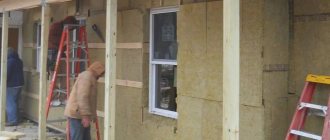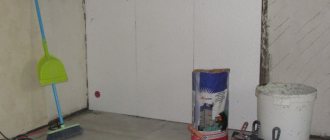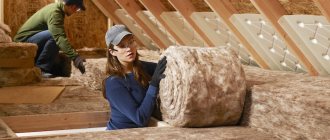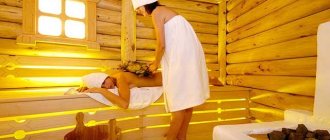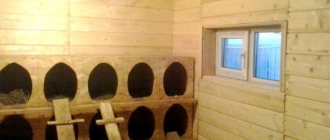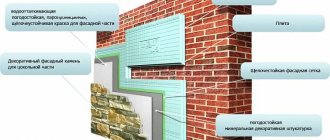Insulating an apartment allows you to significantly save on heating costs in the autumn-winter season. Most often, walls are insulated inside the apartment, and not outside. This is much more economical and does not require the services of professional workers and expensive materials for exterior finishing. For thermal insulation indoors, as a rule, structures made of metal profiles and plasterboard sheets are used. This method is easy and quick to install. Today you will learn how to independently install a plasterboard structure in an apartment.
How well does drywall retain heat?
Plasterboard sheets, among other advantages, have a low thermal conductivity coefficient. For this material it is 0.15, which is ten times lower than that of reinforced concrete. This allows you to significantly retain heat in the apartment and not let in cold air or summer heat.
Typically, to enhance the effect of wall insulation, additional materials are used that are placed between the main wall and the new structure. Polystyrene or foam plastic can be used for thermal insulation. These materials are easy to work with, but they are not often used in insulation. The main problem is that their effects on the human body have not been fully studied. In addition, they do not absorb sound well, and small rodents can damage them. Glass wool is used more often due to its budget cost and low thermal conductivity.
The disadvantage of the material is that it must be installed only with gloves. The composition of glass wool causes itching and irritation upon contact with the skin. Basalt wool is very similar to glass wool, but it is made from rocks of magnetic origin. One of the highest quality heat and sound insulating materials is isolon. It is sold in thin sheets, which allows you to not change the area of the room too much.
Required thickness
In each climate zone, it is important to choose the right thickness of penoplex for insulating walls from the outside, since such positioning allows you to protect the masonry from freezing and extend the service life of wall structures. A final non-ventilated coating will need to be applied to the front side, which will protect the polymer from the effects of outside air.
It will be necessary to apply a finishing non-ventilated coating to the front side, which will protect the polymer from the effects of outside air.
The value of the thermal resistance of the wall is recommended by SNiPs for each region. In an abbreviated version, the SNiP table 02/23/2003 looks like this:
The specified resistance value is obtained by the sum of the indicators of all materials used, including finishing coatings.
Calculation
As an example, we can take a Moscow wall with a thickness of 1.5 bricks, which will be 0.38 m. The thermal resistance of such masonry is 0.76 m²×°C/W (the thermal conductivity coefficient of brick is 0.5 W/m²×°C, 0 .38:0.5=0.76). The remaining resistance value (3.14-0.76=2.38 m²×°C/W) is provided by insulation and finishing materials. If we multiply the thermal conductivity of penoplex by 0.028 W/m²×°C, we get the required thickness of 6.6 cm. Taking into account external plaster and interior decoration, it is permissible to choose slabs 5 cm thick.
The practice of performing work has shown that when using standard sheets of extruded polystyrene foam, the insulation layer on average is made of the following thickness:
- for internal insulation of premises, slabs with an end face of up to 4 cm are sufficient;
- for external arrangement in a temperate climate, set 5 cm;
- in cold zones 10 cm and conditions of the far north 15 - 20 cm. For more information on calculating the thickness of insulation for walls, see this video:
Before working with this material, we recommend that you familiarize yourself with the technology of wall insulation with penoplex.
Types of penoplex
Penoplex is produced in the form of 5 main varieties, differing in the purpose of the types of work.
- Fundamental. They are mounted on the basement (underground) part of the building and used as permanent formwork. Protect the base of the building from freezing.
- Wall. Needed for external work on thermal and sound insulation.
- "Roof". Installed on attic floors and roof slopes, attic spaces. Blocks heat and sound from rain.
- "Comfort". Designed for interior work (walls, floors, ceilings, balconies).
- Road. The densest grade of this material is labeled “penoplex-45”.
Work on installation on the outer part of the wall is no different in composition from performing internal insulation.
Installation of gypsum board sheets
If working with drywall is new to you, you need to first familiarize yourself with some of its features. Before installing the guide profiles, a special tape is laid along the intended installation lines. It will serve as protection against contact with plaster. In this case, the drywall will be protected from the cold that comes from the metal profile.
Metal profiles are usually installed at a distance of 2 cm from the wall. It is recommended to install a frame made of galvanized profile. After installing the frame, insulation boards are placed behind it. The material must be inserted vertically. In no case should the edges of the insulation protrude beyond the front side of the profile.
What is needed to install drywall in a wooden house?
To carry out the work, you need to buy a metal profile for the frame, sheets of drywall, insulation, screws, putty, wallpaper and glue or paint at the construction market or in a specialized store. To work, you will need various tools: special construction knives with replaceable blades (they are used to cut drywall), a hacksaw, an electric drill, an angle grinder with discs, a screwdriver or screwdriver, spatulas, paint brushes, and some consumables.
The tool must be of high quality and reliable.
Step-by-step insulation with plasterboard (video)
When installing additional insulation, they should fit comfortably between the main wall and the plasterboard structure. To install rolled thermal insulation materials or better secure the slabs, it is recommended to glue them to the main wall or use special umbrella dowels. They differ from standard ones with a large cap.
To prevent moisture from accumulating in the insulation and losing its properties, it is covered with a special vapor barrier membrane. This material will be a barrier to warm air that leaves the room through sheets of drywall. Next, the plasterboard sheets are attached to the structure using self-tapping screws. Quite often, wooden rather than metal fasteners are used, because they have lower thermal conductivity. However, wood also has a disadvantage - it becomes deformed over time.
After installing the drywall, further finishing of the room is carried out. Following the processing of drywall, which we wrote about earlier, wallpaper, tiles, decorative stone or other finishing materials are glued to the walls.
What not to do
Often, when trying to limit themselves from noise, many people use materials that are not the most suitable for this. First of all, this applies to polyurethane foam.
Not only does it provide poor protection from noise, but it is also not fire safe. The foam melts perfectly and releases a suffocating gas. The same can be said about polystyrene foam.
By creating a simple partition made of gypsum sheets to protect against noise, and not filling it with a noise absorber, they thereby turn it into a large resonator, which only worsens the situation.
Insulation from sound penetrating through technological openings - sockets, air ducts and the like - is required. If nothing special is done with the air ducts and ventilation ducts, then the outlet can be treated from the inside even with a simple sealant, which, although slightly, will reduce the amount of incoming noise.
When using roll sound insulators and membranes, you must not leave joints or gaps between the parts of the coating. It is necessary to glue them overlapping.
Insulation of an unheated room
Many novice builders are interested in the issue of installing gypsum board in an unheated room. We warn you right away: most professionals are against such installation. The fact is that even moisture-resistant material cannot withstand strong changes in temperature and humidity. If you decide to install plasterboard structures in such a room, but do not want to install additional thermal insulation, it is enough to attach the sheets to a frame made of metal profiles. The air between the structure and the main wall will provide some thermal insulation.
It is possible to insulate an unheated room, such as a loggia or balcony, only under certain conditions. Firstly, it must be glazed. We are not talking about simple wooden frames, but at least double-glazed windows. They provide reliable protection from moisture and cold. In addition to the walls, you will need to insulate the floor and ceiling, which are covered with high-quality moisture-resistant plasterboard.
GCR can be used in loggias that are connected to a living room with a normal microclimate. Think carefully before you start installing drywall in such rooms, because the structure “eats up” at least 6-7 cm of space. Thermal insulation in the loggia is carried out in the same way as in ordinary rooms, but with some features. First, the wall is covered with waterproofing material.
Common Mistakes
At first glance, insulation work looks simple. However, inexperienced installers may make mistakes that will not allow them to achieve the required thermal insulation properties or may lead to delamination of the material. Most often, beginners make the following mistakes:
- The number of slabs is calculated incorrectly or the design stage is completely neglected. There is not enough material or there is a large residue.
- During installation, moisture is allowed to enter the work surface or the temperature regime is not observed.
- The place and tools are poorly prepared. This increases the risk of damage to the insulation or contamination of surfaces.
- They do not follow a checkerboard pattern when laying them. Because of this, cracks form and heat escapes from the room.
- Glue is applied unevenly or in insufficient quantities.
- Neglect grinding the material. The grip becomes less strong.
- Do not fill the seams with foam.
To insulate the joints, fill them with polyurethane foam.
conclusions
If you approach wall insulation responsibly, you can create an atmosphere of comfort in any apartment. We hope that our simple instructions will help you implement this plan. Good luck.
It is not easy to make thermal insulation of a multi-storey building; special equipment is required. But insulating the walls inside with mineral wool or plasterboard gives a good effect. With proper installation, heat loss is reduced by 20-30%. The main thing is that the thermal insulation layer in the room corresponds to the technology. We will tell you in this article how to properly insulate walls from the inside of a living room with plasterboard.
Additional tips from the experts
It happens that after completing the process, the plaster may crack or fall off. This means that the technology was not followed during the work, or low-quality materials were chosen. There are some more tips from the experts that will help you avoid mistakes:
- When plastering walls near doors, it is better to install the mortar flush. And seal the adjacent parts of the doors with masking tape.
- Some people feel sorry for throwing away the remaining mortar, and they apply it to an already dry wall. There is no need to do this so that the new layer does not fall off from the old one over time. The reason for this is the layer thickness and temperature.
- You cannot work if there is a draft in the room. The optimal temperature inside is from 10 to 20 degrees.
Penoplex is an excellent option for insulation. And if you know how to plaster it correctly, the house will be reliably protected from negative influences. And thanks to the decorative layer, it will be transformed and will delight its owners for a long time. The main thing is to follow the technology, do the work slowly, carefully and efficiently. If possible, ask a friend or relative for help.
Types of drywall and its use
Drywall can be used to insulate walls inside a building. Use either moisture resistant or wall.
Moisture-resistant can be used in dachas or for rooms with a high degree of humidity: bathrooms and kitchens.
Important! Moisture-resistant plasterboard, the best solution for rooms where heating is not provided.
This material is not at risk of cyclical temperature fluctuations. After installing the sheets, you only need to apply a waterproof primer or protective paint to the front part. You should also treat drywall with an antiseptic to kill harmful germs and bacteria.
Types of insulation
It is better to insulate the surface under drywall using mineral wool or polystyrene foam. You can also use isolon or penoplex. These insulators differ in installation methods, cost, and strength.
According to research, polystyrene foam, like polystyrene, is harmful to health. It is rarely used in residential premises. Another disadvantage is that some types of foam are eaten by rodents. But it has a low cost and is also available in many densities and sizes.
Example of insulation with plasterboard and mineral wool
As for mineral wool, the advantages include low weight (especially important for insulating old buildings), as well as low thermal conductivity. There is only one significant disadvantage of mineral wool - hygroscopicity. Therefore, when thermally insulating partitions and walls, it is necessary to prevent the accumulation of condensation. For this purpose, vapor insulation should be used.
There are several types of mineral wool. They all differ in the production method, composition and technical indicators. Among the types of wool that are on the market, the most popular is fiberglass-based basalt wool. Like other types of insulation, they have both advantages and disadvantages.
The main negative aspects of glass wool:
- The thermal conductivity indicator is greater than that of stone, and therefore heat disappears faster.
- At elevated temperatures it forms a solid glass mass.
- Inconvenient to work with (glass wool fibers can cause itching; requires the use of protective glasses, gloves, a respirator, and wearing a thick suit).
Important! For greater efficiency, it is necessary to lay mineral wool in 2-3 layers.
Despite their external similarity, basalt and glass wool are significantly different. Glass wool is made from very thin glass fibers, and basalt wool is made from volcanic rock. They also differ in the indicator of thermal conductivity, which is lower in basalt, and, therefore, it retains heat better.
Cost of materials for insulation:
- The cheapest way would be to insulate the walls of the house with polystyrene foam, the price of which ranges from 70-90 rubles. for 1 sq. m.
- As for mineral wool, it costs a little more - 90-150 rubles. The price of the material depends on its density, thickness and manufacturer.
- Penoplex, which is extruded foam plastic, but with increased strength and density, costs 1 sq. meter approximately 200 rubles.
Isolon (foamed polyethylene) can also serve as an insulator. Its cost will be 280-300 rubles per 1 square meter.
Selection of thermal insulation filler
Experts believe that insulating external walls is more effective. But in multi-storey residential buildings it will be almost impossible to carry out work independently. But the use of plasterboard as insulation allows you to significantly save on hired labor and achieve high thermal insulation properties. At this stage, the most important issue will be the choice of insulation. Currently used:
- Styrofoam;
- glass wool;
- isolon;
- basalt (stone) wool.
Foam plastic remains relevant in the insulation market. However, in residential premises it is better to avoid insulating walls with this material. Firstly, rodents love it, so over time the insulation layer will lose its properties, and warm air will begin to leave the room through the holes that appear. And to replace the foam, you will have to open the trim, i.e. go through the renovation again. Secondly, foam plastic has low sound insulation and does not “breathe”. A residential apartment will require additional ventilation. If you still choose it, then you will be pleased that it is a very simple and easy material to work with.
Glass wool also has low thermal conductivity, but this is a specific material that attracts only its low price. Its main disadvantage for internal wall insulation with plasterboard is the presence of glass fibers, which, if they come into contact with the skin, cause itching and burning. When working with glass wool, it is necessary to wear gloves, protective clothing and a respirator only. Such inconveniences, as a rule, repel buyers, so they are practically not used in residential premises.
Isolon is much more in demand. This material has a number of advantages. It not only retains heat, but also does not allow noise to pass through, which allows you to save on sound insulation. Do-it-yourself work on insulating walls from the inside takes up not only time, but also the usable area of the room. Izolon has a small thickness, which allows owners not to worry about meters “eaten” by the insulation.
Basalt wool is often used in the thermal insulation of walls. In terms of its properties, it is most similar to glass wool, but differs in composition. Rocks are used in its production, which makes it fire-resistant and hypoallergenic. But its disadvantage is the price; it is more expensive than glass wool and polystyrene foam.
Each apartment owner must answer the question of how to insulate walls with plasterboard. You need to build on your financial capabilities and your preferences. I would like to give only one piece of advice: if possible, purchase insulation in the form of slabs, not rolls. This will make the work easier and faster. The slab insulation has a standard width of 60 cm, which corresponds to the mounting step of the frame profile.
Stages of thermal insulation of a wall
In order for the work process to proceed quickly and properly, you should prepare the necessary tools. This will significantly speed up the work on protecting the walls with insulation.
The following materials will be required:
- plasterboard sheets;
- self-adhesive tape;
- insulation;
- membrane to ensure maximum vapor barrier;
- screws, nails;
- hammer, screwdriver, hacksaw;
- yardstick;
- metal profiles or wooden slats for constructing the frame;
- fastening materials.
For 1 sheet you need approximately 30 pieces of self-tapping screws. It is best to buy screws 20 mm long.
As for the manufacture of the frame, the profile must be taken of 2 types: marked CD and UD. The length is selected based on the size of the room.
Frame design
It consists of drawing the perimeter and thinking through how the frame will be positioned on the wall. A simple pencil and a building level are enough.
Advice! For the best insulator effect, the structure must be positioned 3-10 cm from the wall.
- surface cleaning;
- smooth out all the unevenness and fill up the cracks and depressions;
- drying with a heater or blow dryer;
- getting rid of mold and mildew.
Sometimes it is necessary to treat the walls with a special waterproofing putty to prevent the occurrence of dampness. First, the layer is applied vertically, then horizontally.
Frame construction
According to pre-made marks, you need to mount the frame. To avoid contact of the metal structure with the wall, a tape prepared in advance is glued to the base of the profile. The frame parts are fastened to the wall using self-tapping screws and dowels.
Before laying the insulator, the surface is prepared in advance. Weak areas of plaster are removed or restored. To eliminate the possibility of the formation of fungus and mold, it is necessary to treat with a primer and an antiseptic.
Sheets of plasterboard are installed on a frame made of metal or wood. A metal frame will last significantly longer than one made of timber.
In the area where batteries are located, where installing thermal insulation is difficult, penofol can be used.
You can make a frame from bars under drywall
Assembling the frame begins with the installation of guides created from the UD profile. The slats are mounted on the ceiling and floor with a distance of 50-60 mm from the walls. A section of the rack profile is inserted into the guides. The ends are fixed using small self-tapping screws (“fleas”). The edges of the hangers are folded from the sides and connected to the slats. The pitch between the profiles must be observed so that there are 3-4 slats per sheet.
Important! When the frame is constructed, they begin to lay the insulator.
To improve the rigidity of the structure, it is necessary to make transverse bridges from the CD profile. The profile is cut so that its length overlaps the adjacent slats by half. Use metal scissors to cut off the shelves. Then the blanks are fixed with fleas onto the frame.
Insulation of balcony walls
As for the insulation of balconies and loggias, such structures require compliance with certain rules.
The material for thermal insulation must be:
- waterproof (since there is a high probability of water appearing on the balcony);
- you need to buy only moisture-resistant drywall;
- walls should be treated with an antiseptic.
To insulate balconies, a frameless method is often used. This is due to the fact that such a space has a small area. The insulator creates a higher degree of structural reliability, despite various influences: tension, humidity and other loads.
Initially, the walls are prepared for fastening the sheets. All fragile areas are restored, and the surface is treated with an antiseptic substance.
As soon as the walls are prepared, the installation of sheets begins. Initially, they need to be cut into the necessary pieces. It is not recommended to cut sheets right away; it is better to do this as you work.
Once the material is prepared, you can begin fixing it. This should be done using an adhesive composition. This is the easiest way to attach gypsum boards. When carrying out such work, you need to ensure that the layer of the mixture is the same everywhere.
Thermal insulation allows you to protect the house from dampness, drafts and provide a favorable and comfortable microclimate. After all, with insulation, like a shield, you can isolate yourself from the harmful influence of the environment.
With the help of room insulation, you can protect your home from dampness, drafts and create a pleasant microclimate. After all, insulation, like a shield, manages to isolate itself from the adverse effects of the external environment.
One of the best ways to save heat is to insulate the walls from the inside with plasterboard.
Drywall is a material that has undeniable advantages over other finishing methods. It is very convenient to use, and the thermal insulation is inexpensive and beautiful.
What thermal conductivity coefficient does drywall have? Thermal conductivity usually refers to the ability of a substance to transfer heat to the coldest areas from the hottest areas. Materials with lower values retain more heat. Drywall has a thermal conductivity value of 0.14 - 0.15. For example, reinforced concrete (the most common partitions in houses) has a high value - at least 1.5. And for various types of insulation, this figure is five to six times lower than for drywall.
Wall insulation under plasterboard is often used both in large office premises and in ordinary apartments, especially corner ones, when external insulation is problematic or expensive.
Types of noise protection partitions
For interior screens or barriers between the kitchen and one room, the lowest Rw value is approximately 43 dB, between other areas and the bathroom it is about 47 dB. However, not only this parameter is important for good sound insulation.
Low-frequency noise created by functioning electrical appliances is also important. The sound background is quite irritating, although not loud. For example, when comparing a partition monolithic structure and a light frame that have an equal index value, the monolithic structure reflects low-frequency waves an order of magnitude better. For maximum protection from unpleasant sounds, a lightweight structure is installed, filling it inside with a sound-absorbing layer.
We list the types of partitions with sound insulation:
- Frame partitions made of building materials with special layering. The outer side is designed to reflect noise, and the back is to absorb. They reduce noise pressure and its saturation to a level that is not dangerous for the human nervous system.
- Sound-absorbing structures made of building materials that absorb sound wave energy. Also designed to reduce noise and its intensity.
- Soundproof structures - absorb and isolate noise at the same time. They completely block sounds, preventing them from either entering or leaving the apartment. These are, for example, multi-layer barriers, where noise reflected from plasterboard cladding is absorbed by a soft inner layer.
The level of silence in the room depends on how hard the outer and soft inner layer of the material is. Experts say that plasterboard screens are superior to glass partitions and monolithic products in terms of ease of installation and savings in usable space.
In offices/panel houses, the internal and load-bearing walls do not have good sound insulation. Monolithic partitions for offices made of gypsum tongue-and-groove slabs perfectly transmit sound. There are two ways out here - replace the sound insulation of tongue-and-groove slabs with multilayer gypsum plasterboards with a layer of sound insulator, or sew up, for example, in an office with soundproof partitions, and gypsum plasterboard on top. The second method is simpler, but it will “eat up” valuable centimeters of space. Sound insulation can be improved through upholstered furniture, draped curtains, acoustic mobile partitions, and carpet.
Which drywall is best to use?
The length and width of all sheets are standard (length 2.5 m -3 m, width 1.2 m). In terms of thickness for walls, you need to take sheets of 12.5 mm (9.5 mm is ceiling plasterboard). But the type will need to be determined depending on the room and functions. There are:
- standard;
- moisture resistant;
- increased strength;
- windproof and waterproof;
- fire resistant;
- types of material.
There are three methods of insulation using this technology:
- adhesive method of attaching gypsum boards directly to the wall;
You can fix the drywall directly to the wall with gypsum or cement-polymer glue. Perlfilks from Knauf is used as gypsum glue. With this type of finishing, the area of the room is not reduced, and sound insulation appears - this is an advantage. The disadvantage is that you cannot install thermal insulation and the walls must be strong. Insulating under drywall in this way produces very little heat and is therefore not recommended.
frame method, without further laying of any insulation;
Plasterboard sheets are mounted on a frame made of metal profiles or wood. A metal frame will last much longer than timber slats. Wood can dry out and become deformed, especially in the event of sudden temperature changes. When using this method, everything is simple - even without installing additional insulation, the layer of air between the wall and the plasterboard sheets provides thermal insulation.
frame method with insulation
Here, the distance between the mounted drywall and the wall surface must necessarily be equal to the thickness of the insulation. The distance between the vertical beams and the frame profiles is usually half the width of the plasterboard sheet. As a rule, one layer of insulation is sufficient. In the area of batteries where installation of thermal insulation is difficult, penofol can be used.
How to choose materials
Previously, before the invention of drywall, sound insulation was achieved by building a heavy brick or concrete wall. But it is obvious that this increases the load on the floor. Even earlier, partitions were made from so-called shingles. This is an interlacing of wooden slats, smeared with clay. This material is fragile and flammable, and the durability of the wall leaves much to be desired, fire safety even more so.
Fortunately, drywall is free from the following disadvantages:
- The material is non-flammable. If you choose a metal frame and mineral wool insulation, then you don’t have to worry about a fire in such a room. Plaster does not burn.
- The weight of one meter of brickwork is almost one and a half tons. A square meter of a single-layer gypsum partition weighs only 50 kg.
- A plasterboard partition is easy and quick to install. You just need to carefully mark everything and follow the instructions.
- The excellent sound insulation of the plasterboard surface in combination with other qualities makes the material the best option for building an interior wall.
The ceiling is both beautiful and protects from noise
What insulation to use
To prevent convection air flows and increase the thermal resistance of the walls, the frame cells are filled with thermal insulation material.
The most common types of insulation used as insulation under plasterboard sheets:
- Styrofoam. Now they often write about its dangers (along with polystyrene) for health. It is rarely used in residential premises. The second disadvantage is that rodents eat it. But this type of material is cheap and available in many sizes and densities.
- Stone wool. The advantages of mineral wool include lightness (especially important for insulating old buildings), as well as low thermal conductivity. The air layer that appears between the mineral fibers turns this material into a kind of thermos. There is only one significant drawback of mineral wool - hygroscopicity. Therefore, when thermally insulating the walls of premises from the inside, it is necessary to prevent the accumulation of condensate and provide a vapor barrier.
- Glass wool. Made from thin glass fibers. Has a number of disadvantages:
Main types of penoplex
Penoplex can be used as insulation in the construction of new buildings, as well as for thermal insulation of old ones. In addition, the universal material can be used for various surfaces and areas of the building
It is important to choose the right type of penoplex:
- Series
K. This material is created for thermal insulation of roofs and roofs. It is lightweight, waterproof and has a relatively low density - 28-33 kilograms per cubic meter. Can be used for pitched and flat roofs. - Series
C. Wall insulation. Its density ranges from 25 to 35 kilograms per cubic meter. It is used to insulate external and internal walls. - Series
F. Thermal insulator for foundations and basements. The material has special strength characteristics and high density - up to 37 kilograms per cubic meter. In addition, it is completely waterproof and biologically resistant. - Series "Comfort"
. This is the most versatile type of penoplex. Density - from 25 to 35 kilograms per cubic meter. It is used for insulation of city apartments, balconies, loggias. - Penoplex "45"
. This is the most durable type of heat insulator. The density of penoplex in this series is 35-47 kg/m3. Used in the construction of roads and runways. Effectively protects against the damaging effects of low temperatures.
In addition, foam sandwich panels have recently appeared on the construction market. This is an improved insulation material that is often used to insulate attics and facades. The panel consists of two or three layers. On one or both sides it is lined with cement bonded particle board.
Advantages and disadvantages
The undoubted advantage of insulation under plasterboard is the geometrically ideal surface of the walls and fairly high thermal insulation efficiency. The disadvantage is that the thickness of the frame for attaching drywall “eats up” part of the area of the room, which is very important or simply unacceptable for a small room. It should also be noted that plasterboard has a low load-bearing capacity: heavy shelves and other interior elements cannot be hung on it. This problem can be solved by installing additional vertical frame profiles or anchors attached to the wall through sheets of drywall.
Another inconvenience of use is the fact that drywall is not characterized by mechanical strength. If hit, it may break. Untreated sheets, when subjected to force, emit dust that negatively affects the human condition.
Wall thermal insulation technology
Insulating walls with plasterboard is very widespread, so the technology is well established. Carrying out work with drywall on your own is quite problematic; you will need a second person, as well as certain skills and, of course, special tools. But if you wish, if you prepare everything correctly and call an assistant, you can do the work yourself.
1. Procurement of tools and materials
- the drywall itself;
- materials for the frame (metal or wooden slats);
- insulation;
- self-adhesive tape;
- fasteners (screws and dowels);
- vapor barrier film;
- putty;
- antifungal liquid
2. Preparing the walls
The process includes:
- surface cleaning;
- putty of cracks;
- drying with a hair dryer or heater;
- removing traces of mold and mildew;
- It may be necessary to treat the walls with a special waterproofing putty to prevent possible dampness. In this case, the first layer is applied vertically, the second horizontally.
3. Marking walls for frame assembly
This is done using a level and plumb line.
4. Frame installation
Still, a metal frame is more technologically advanced than a wooden one. Self-adhesive tape is glued to the profile attached to the floor, which improves sound insulation.
5. Fastening the insulation
The thermal insulation layer is attached tightly, without gaps. You can glue it to the wall with special glue or use the “umbrellas” used to attach foam plastic.
6. Vapor barrier device
If penofol is used, you need to make sure that the foil side of the material is facing inside the room.
If the insulation of walls under plasterboard is provided with a vapor barrier material with a rough surface, then the uneven side should face inward. It serves to trap moisture with its further retention on the fleecy surface. By ventilating the structure, excess liquid is removed.
7. Installing drywall
8. Processing of joints
Putty is applied to the joints of plasterboard sheets, reinforced with a special plaster mesh - “serpyanka”. If several layers are applied, you need to wait until the previous layer dries.
9. Decorative finishing. Painting or wallpapering
Preparing the penoplex surface
Penoplex (more accurately called extruded polystyrene foam), which was installed on the external wall of the house for insulation, can and should be further processed. In order for the plaster to protect this insulation, guarantee fire safety, create aesthetic appeal, and evenly smooth out unevenness, you need to properly prepare the surface, choose the right putty material and apply it correctly.
Tools and materials that will be needed for proper plastering of penoplex on the exterior walls of a residential building:
- wide spatula or American;
- polyurethane foam;
- scissors for cutting the reinforcing mesh;
- narrow spatula (10-12 cm);
- primer;
- grater (to remove excess foam);
- building level;
- fry;
- notched spatula (for the so-called pulling of the surface of the adhesive composition for the reinforcing mesh);
- rule;
- stationery knife;
- umbrella dowels, a hammer drill for making a hole for the umbrella and a hammer (if necessary);
- metal construction corners;
- construction mixer (for mixing);
Tools for plastering penoplex outside the houseSource kraski-net.ru
- primer (deeply penetrating);
- a brush with an emery base or sandpaper;
- container for stirring construction and finishing mixtures;
- a rag or rags (to remove dust from the surface before starting work);
- reinforcing mesh (the smaller the cell, the better the reinforcing properties of this material);
- flat containers for diluted building mixtures;
- roller for applying primer;
- plaster.
To ensure that the insulating polystyrene foam surface is ideal for plastering, you will need to check the following points:
if there are gaps between the plates of material, it is necessary to fill them with polyurethane foam intended for heating installation work, and cut off the excess with a knife and rub it with a float;
How to seal gaps between foam boards using polyurethane foamSource vdome.club
If one or more “umbrellas” have been cut off, it is necessary to install new ones next to them so that the strength of the structure is not affected. To do this, you will need to select a suitable place near the cut umbrella dowel, make a hole there using a hammer drill, install the “umbrella” and carefully drive it in with a hammer. In this case, the head of the fastener should sink slightly into the foam insulation material.
All umbrella dowel caps must be recessedSource stroi-baza.ru
After eliminating the flaws in the installation of penoplex, be sure to remove dust from the surface with a rag and only then prime it. To do this, you will need to purchase a deep penetration primer and dilute the dry material as indicated on the manufacturer’s packaging. To conveniently apply the prepared mixture, you need to take a flat container and a construction roller. Before applying the mixture, you need to squeeze it out a little. After evenly distributing the primer over the surface of the penoplex, you must wait until the finishing material has completely dried.
When the surface has become smooth and primed, you can begin reinforcing. To do this, you will need directly alkali-resistant mesh with a density of 140-160 g/m2 made of fiberglass material, perforated aluminum corners and special glue.
Installing mesh on penoplexSource baumitpro.com.ua
To reinforce penoplex, you need:
- make the glue so that it is a little thinner than the manufacturer advises on the factory packaging;
- cut the mesh so that their length matches the height of the walls, and the width ranges from 60 cm to 100 cm (allowances must also be taken into account);
- apply an adhesive composition approximately 3 mm thick to the penoplex;
- walk with a notched trowel over the entire treated surface to level the layer of mesh adhesive;
- quickly apply the mesh to the pre-designated gluing area using a small trowel or a wide spatula, using the technique of circular or vertical movements (each subsequent piece of the surface for gluing the mesh must be processed gradually from top to bottom or bottom to top, but without changing direction);
- the corners need to be secured using special metal corners (if there are none, you can use a bent mesh);
- After installing the next part of the mesh, it is best to apply another layer of glue on top so that the mesh is completely immersed in the adhesive composition.
Corner reinforcementSource sense-life.com
Thermal insulation of walls in damp and unheated rooms
In such cases, moisture-resistant plasterboard is used. It's more expensive than usual, but don't skimp! Wall cladding with such material is carried out both in rooms where humidity is high, and in very wet ones. Already at the production stage, the ability to withstand moisture is established - plasterboard sheets are subjected to special heat treatment, which helps prevent the appearance of mold and fungi.
The product is pigmented with green dyes to distinguish it from sheets of other types. Special water-repellent and antifungal additives enable this material to retain its unique characteristics even at high humidity. This does not eliminate the need to combat humidity in the bathroom. Such a room must have forced ventilation. It should not be tied to turning the lighting off/on. It is advisable to use a humidity sensor in the electric fan control system.
Moisture-resistant drywall is recommended for use where there is no constant heating. For example, at the dacha. It is able to withstand cyclical temperature changes. It is only necessary after installing the sheets in rooms that are not heated to apply a waterproof primer or protective paint to the front side. It is also recommended to treat drywall with an antiseptic that contains components to destroy harmful microorganisms.
Thermal insulation of walls using plasterboard has a significant advantage over other methods. This is a great way to insulate walls and, at the same time, reduce noise levels in a house or apartment. This indicator is of particular importance if the house is located on a large street, with tram lines or a railway running nearby.
Vapor barrier film
Such raw materials are quite popular among people doing repairs. However, you should consider all the pros and cons.
Flaws
- Since polyethylene does not allow air to pass through, creating a greenhouse effect on the surface, the craftsmen came up with a trick. Some experts recommend walking over the surface of the polyethylene with a needle roller. Thus, according to repairmen, the surface begins to breathe and provides the desired effect. Other experts say that this idea is wrong. In any case, the pores created in this way will not perform the required function, allowing moisture to pass in both directions and not retaining it inside.
- Experts say that the film cannot be confidently positioned as a vapor barrier. The raw material is not specially prepared to perform the function of retaining steam in its coating.
Based on the above, it can be understood that plastic film is not the best option. But, if temporary repairs are required or there are no funds, polyethylene film can be considered as an alternative to professional materials.


